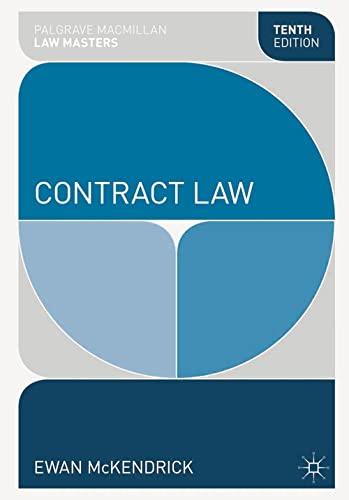Question
Choose the letter of the correct answer. Thank you! 1. The stockholders or members mentioned in the Articles of Incorporation originally forming and composing the
Choose the letter of the correct answer. Thank you!
1. The stockholders or members mentioned in the Articles of Incorporation originally forming and composing the corporation and who are signatories thereof are called:
a. Incorporators
b. Promoters
c. Corporators
d. None of the above
2. Persons who compose the corporation whether as stockholders or members are called:
a. Incorporators
b. Promoters
c. Corporators
d. Subscribers
3. Right of the corporation to continue as a juridical entity for the period stated in the Articles of Incorporation despite the death of any stockholder.
a. Right of succession
b. Right of pre-emption
c. Right of existence
d. None of the above
4. This class of shares are those issued for no consideration or inadequate consideration:
a. Bonus shares
b. Coupon bonds
c. Over-issued shares
d. Watered shares
5. The debt of a stockholder is not a debt of the corporation of which he is a stockholder, and conversely, the debt of the corporation is not a debt of any of its stockholders is based on the -
a. separate and distinct personality principle
b. trust fund doctrine
c. piercing the veil of corporate fiction
d. limited liability principla
6. In corporation law, the foundation of the primary doctrine of "strong juridical personality" is -
a. the right of succession
b. the limited liability rule
c. the doctrine of free transferability of shares of stock
d. the principle of centralized management
7. Shares of stock that have been issued by the corporation for consideration reflected as equal to the par or issued value of the shares, when in fact the amount actually received was less, would technically be called -
a. Discounted stock
b. Premium Stock
c. Watered Stock
d. Void stock
8. Which of the following best describes a corporation organized under the laws of the State of New York but owned 100% by Filipino Citizens?
a. A New York Corporation
b. A Filipino-owned corporation
c. A Filipino-owned corporation
d. A Filipino-owned New York Corporation
9. Which of the following reflects a correct legal precept?
a. Private corporations under the Corporation Code are created by law
b. A private corporation may always be held civilly liable for negligent acts committed by its employees.
c. The corporate obligations are, as a rule, not the obligations of the corporate officers as long as the absence of liability of the latter is reflected in the corporate by-laws.
d. Private corporations under the Corporation Code may either be de facto or de jure.
10. Which of the following is in conformity with both law and jurisprudence?
a. The separate personality of a corporation may be disregarded when an incorporator dominates and controls the outstanding capital stock.
b. Shares cannot maintain a suit in their own names to recover corporate property.
c. A corporation does not fall within the constitutional protection against unreasonable searches and seizures.
d. A corporation has a right against self-discrimination
11. An Article of Incorporation is a contract between the following, except:
a. Securities and Exchange Commission and Corporation
b. State and Corporation
c. Corporation and Share holders
d. State and Share holders.
12. A corporation by prescription is a:
a. corporation sole
b. de facto corporation
c. eleemosynary corporation
d. corporation by estoppel
13. Which of the following statements is true in applying the doctrine of piercing the veil of corporate fiction?
a. Corporate insiders (stockholders, directors, officers) can invoke the doctrine of piercing the veil of corporate fiction to pierce the veil of the corporation where they are insiders.
b. Even a single circumstance can be the basis for piercing the veil of corporate fiction in the case purely alter-ego piercing.
c. The doctrine of piercing the veil of corporate fiction cannot be used under any circumstances to hold a corporation liable for the obligations of the stockholders, directors and officers.
d. If the doctrine of piercing the veil of corporate fiction is not applied, the officers of the corporation cannot be held personally liable for their acts as such officers.
14. Which of the following statements is true in applying the trust fund doctrine?
a. The trust fund doctrine only applies if a corporation has corporate creditors; otherwise, it has no application whatsoever.
b. The trust fund doctrine only reserves an amount corresponding to the outstanding capital stock of a corporation.
c. The trust fund doctrine applies whether or not a corporation is insolvent
d. The trust fund doctrine does not apply if a corporation is not yet incorporated or is already dissolved.
15. Which of the following statements is true in applying the corporation by estoppel doctrine?
a. Corporate insiders (would be stockholders, directors, officers) cannot invoke corporation by estoppel doctrine with respect to dealings they have with the ostensible corporation.
b. Notwithstanding that a corporation is eventually incorporated; the acts performed by the incorporators while the application for incorporation is pending will be governed by the corporation by estoppel doctrine.
c. All persons who are associated with the ostensible corporation shall be liable as general partners under the corporation by estoppel doctrine.
d. Only persons who actively represent themselves and act as a corporation knowing it to be without authority to do shall shall be liable as general partners under the corporation by estoppel doctrine.
Step by Step Solution
There are 3 Steps involved in it
Step: 1

Get Instant Access to Expert-Tailored Solutions
See step-by-step solutions with expert insights and AI powered tools for academic success
Step: 2

Step: 3

Ace Your Homework with AI
Get the answers you need in no time with our AI-driven, step-by-step assistance
Get Started


